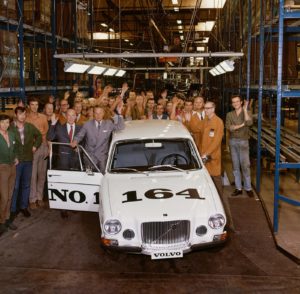In 1958, Volvo said goodbye to the six-cylinder era in the passenger car division for a period of 10 years. The "PV 831-PV 834" series was then taken out of production. It then took a decade before the Swedes took a new six-cylinder model into production. Volvo returned to the ranks of European motorized cars. And launched the Volvo 164 in August.
At the latest, the new flagship from Gothenburg had many similarities with the 144, which was born two years earlier. However, the newcomer had a wheelbase grown with 10 centimeters. Yet the new 164 was especially recognizable by a distinctive front design, in which two large headlights and two smaller lighting units encircled a large square grille with rounded corners. That grille also determined the shape of the bonnet, which had an elevation that "flew" from the grille to the windshield.

Impressive engine, adjusted transmission
In that bow was the six in line B 30 A engine with a displacement of 2.979 cc, which was ventilated by 2 Stromberg 175 CD 2 SE carburetors. To be able to serve that heavier engine well, the transmission was made heavier. In addition, the buyer had the choice of a synchronized four-speed gearbox with or without overdrive. And for those with an even greater appetite for convenience, a three-stage Borg Warner Automatic was available. From 1972, the gear lever moves to the floor.
Injection accompanies carburation engine
In the meantime, the Volvo 164 has been adjusted. From the early 1970s, power steering was a standard feature, the Volvo was fitted with leather and the wheelbase of the topper in the Swedish range grew by another two centimeters. The 164 also received larger footwear. The most important addition, however, came to the credit of …… the power source. From 1971 - in addition to the original power source - the B 30 engine was fitted with the electronic Bosch D-Jetronic injection system. For some markets the power for that engine came to 160 PK, for other countries the power was limited to 145 PK from an environmental point of view, partly due to a lower compression. The injection addition in any case led to a number of changes, such as the use of ventilated brake discs.

Even more attention to safety and luxury
For 1973, the carburetor B 30 A- disappeared from the scene. At the same time, the 164 evolved. For example, recessed door handles (from 1972) and new square rear light units were introduced. A new safety steering wheel and dashboard find their way into the interior of the Swede, the grille became smaller and the front bumper became straight. The doors were fitted with beams for extra protection in the event of a collision. Volvo also mounted air conditioning preparation in its top model. And for the 1974 model year, new safety bumpers were fitted to the top model from Sweden on the front and rear. In the run-up to 1974, the front ventilation windows also disappeared. In addition, the Swedes built in additional crumple zones and made their name in the field of safety further thanks to a few other adjustments (for example the relocation of the fuel tank). A luxury addition was the installation of electrically heated front seats.
Also changes for the last model year
The perfected 164, for example, ran slowly towards the last model year, for which some changes (seats, parking brake, improved suspension) were also planned. In that final model year - 1975 - the Volvo, which was responsible for the return to the six-cylinder class, made way for the 264, which already saw the light of day a year earlier. The 164 ran a total of 153.179 times and was sold both in Europe and in the United States of America. It was a noble, respectable and impressive car anyway.


